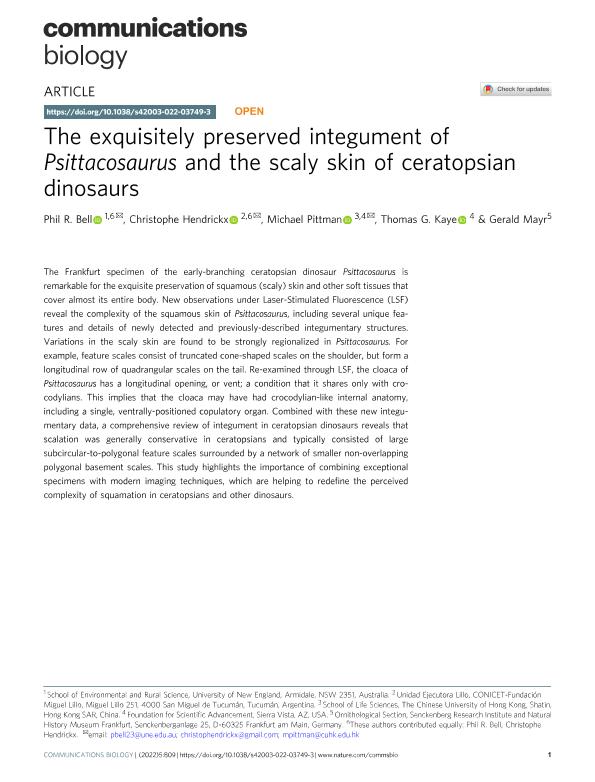Mostrar el registro sencillo del ítem
dc.contributor.author
Bell, Phil R.
dc.contributor.author
Hendrickx, Christophe Marie Fabian

dc.contributor.author
Pittman, Michael
dc.contributor.author
Kaye, Thomas G.
dc.contributor.author
Mayr, Gerald
dc.date.available
2023-09-12T12:38:59Z
dc.date.issued
2022-12
dc.identifier.citation
Bell, Phil R.; Hendrickx, Christophe Marie Fabian; Pittman, Michael; Kaye, Thomas G.; Mayr, Gerald; The exquisitely preserved integument of Psittacosaurus and the scaly skin of ceratopsian dinosaurs; Nature Research; Communications Biology; 5; 1; 12-2022; 1-16
dc.identifier.issn
2399-3642
dc.identifier.uri
http://hdl.handle.net/11336/211193
dc.description.abstract
The Frankfurt specimen of the early-branching ceratopsian dinosaur Psittacosaurus is remarkable for the exquisite preservation of squamous (scaly) skin and other soft tissues that cover almost its entire body. New observations under Laser-Stimulated Fluorescence (LSF) reveal the complexity of the squamous skin of Psittacosaurus, including several unique features and details of newly detected and previously-described integumentary structures. Variations in the scaly skin are found to be strongly regionalized in Psittacosaurus. For example, feature scales consist of truncated cone-shaped scales on the shoulder, but form a longitudinal row of quadrangular scales on the tail. Re-examined through LSF, the cloaca of Psittacosaurus has a longitudinal opening, or vent; a condition that it shares only with crocodylians. This implies that the cloaca may have had crocodylian-like internal anatomy, including a single, ventrally-positioned copulatory organ. Combined with these new integumentary data, a comprehensive review of integument in ceratopsian dinosaurs reveals that scalation was generally conservative in ceratopsians and typically consisted of large subcircular-to-polygonal feature scales surrounded by a network of smaller non-overlapping polygonal basement scales. This study highlights the importance of combining exceptional specimens with modern imaging techniques, which are helping to redefine the perceived complexity of squamation in ceratopsians and other dinosaurs.
dc.format
application/pdf
dc.language.iso
eng
dc.publisher
Nature Research
dc.rights
info:eu-repo/semantics/openAccess
dc.rights.uri
https://creativecommons.org/licenses/by/2.5/ar/
dc.subject
Integument
dc.subject
Skin
dc.subject
Scales
dc.subject
Ceratopsia
dc.subject.classification
Paleontología

dc.subject.classification
Ciencias de la Tierra y relacionadas con el Medio Ambiente

dc.subject.classification
CIENCIAS NATURALES Y EXACTAS

dc.title
The exquisitely preserved integument of Psittacosaurus and the scaly skin of ceratopsian dinosaurs
dc.type
info:eu-repo/semantics/article
dc.type
info:ar-repo/semantics/artículo
dc.type
info:eu-repo/semantics/publishedVersion
dc.date.updated
2023-07-07T21:58:00Z
dc.journal.volume
5
dc.journal.number
1
dc.journal.pagination
1-16
dc.journal.pais
Reino Unido

dc.journal.ciudad
Londres
dc.description.fil
Fil: Bell, Phil R.. University Of New England; Australia
dc.description.fil
Fil: Hendrickx, Christophe Marie Fabian. Consejo Nacional de Investigaciones Científicas y Técnicas. Centro Científico Tecnológico - Tucumán. Unidad Ejecutora Lillo; Argentina. Fundación Miguel Lillo; Argentina
dc.description.fil
Fil: Pittman, Michael. Chinese University Of Hong Kong; Hong Kong. Foundation For Scientific Advancement; Estados Unidos
dc.description.fil
Fil: Kaye, Thomas G.. Foundation For Scientific Advancement; Estados Unidos
dc.description.fil
Fil: Mayr, Gerald. Senckenberg Forschungsinstitut Und Naturmuseum; Alemania
dc.journal.title
Communications Biology
dc.relation.alternativeid
info:eu-repo/semantics/altIdentifier/url/https://www.nature.com/articles/s42003-022-03749-3
dc.relation.alternativeid
info:eu-repo/semantics/altIdentifier/doi/http://dx.doi.org/10.1038/s42003-022-03749-3
Archivos asociados
